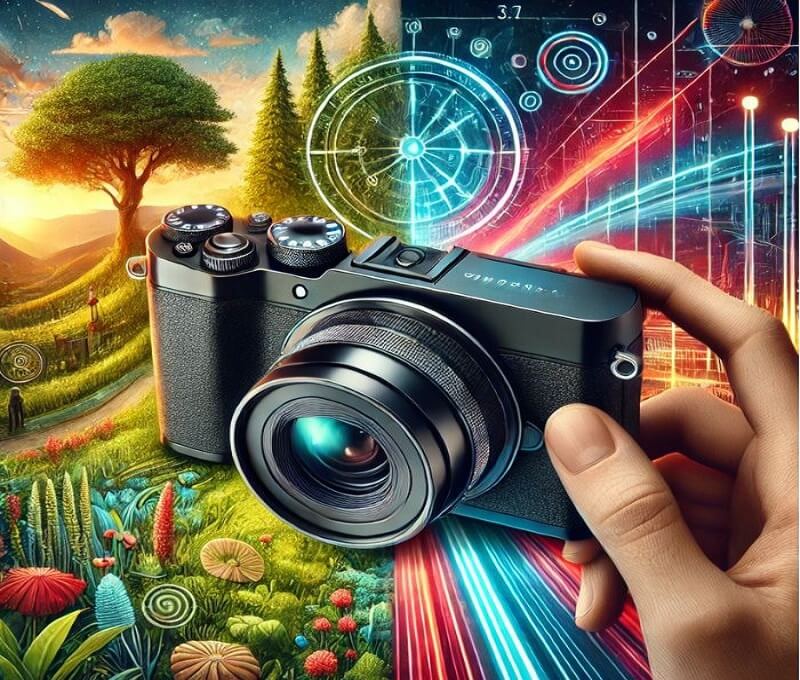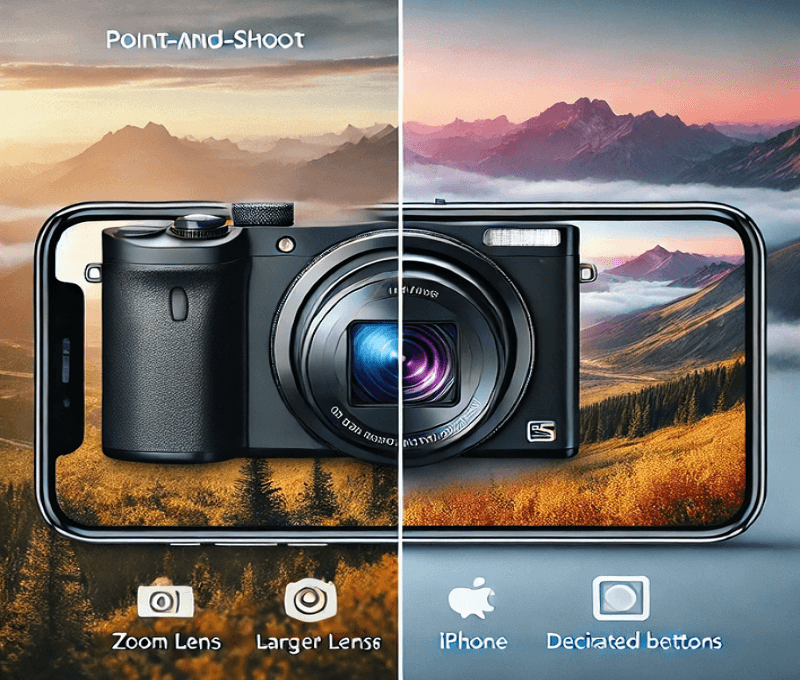There are a lot of things to consider when comparing point-and-shoot cameras to iPhones. Each has its own advantages and disadvantages. It’s easy to see how they compare to each other because:
Those who are serious about photography and those who are just interested in photography are still debating are point-and-shoot cameras better than iPhone models. Smartphones have changed the way we record moments with their ease of use and advanced technology, but many photographers still prefer traditional point-and-shoot cameras. This introduction looks at the pros and cons of both choices, looking at things like image quality, portability, ease of use, and specific features to see are point-and-shoot cameras better than iPhone in today’s digital world.
Image quality and detail
- Point-and-shoot cameras: Most of the time, high-end point-and-shoot cameras take photos with more clarity and detail than camera phones. The main reason for this is that they can take photos with larger files, which means each photo can hold more information. The larger sensors on these cameras also work well in different lighting conditions, so they take better photos in difficult situations.
- iPhones: For example, the quality of photographs on the iPhone 13 Pro is much better thanks to its larger camera, which can capture 84% more light than its predecessor. But iPhones still may not have as much raw information and dynamic range as high-end point-and-shoot cameras, especially in high-contrast or low-light scenes.
Pros and cons
- iPhones: Having a camera in your pocket is by far the most convenient thing you’ve ever had. iPhones let you edit and share photos right away, making them great for social media and quick photo shoots. Third-party apps that are built in give you powerful editing tools right on the device.
- Point-and-shoot cameras: Some newer point-and-shoot cameras can wirelessly share photos, but it’s not as easy as an iPhone. But they usually have more manual controls, allowing shooters to experiment with settings like zoom and shutter speed, which can help them learn to take better photos.
Cost and accessibility
- Point-and-shoot cameras: Regular point-and-shoot cameras are less expensive than newer iPhones, making it easier for those who want to start taking photos without spending a lot of money.
- iPhones: These devices are more expensive, but they can be used for more than just taking photos, which can be enough to justify the price for many users.
Special Features
- Point-and-shoot cameras: These typically have features like real optical zoom, image stabilization, and battery life that help you take pictures when you’re far away or in low light. For example, the Canon PowerShot SX530 HS has a 50x optical zoom and Smart Picture Stabilization.
- iPhones: The iPhone’s artificial photography features, like AI and HDR, can make photos look great out of the camera, especially in JPEG mode 2. When shooting in RAW, however, these benefits aren’t as apparent because the iPhone’s smaller sensor size can get in the way.
Benefits of Manual Control in Point-and-Shoot Cameras

Point-and-shoot cameras with manual settings have a number of important benefits that make it easier for photographers to take accurate, creative, and consistent photos:
1. Creative control and precision
Manual mode: When photographers shoot in manual mode, they have complete creative control over both the look and technical details of an image. This means changing the aperture, shutter speed, ISO, white balance, and focus to get the right look for their art. With this much power, photographers can create unique images that show what they were trying to do artistically.
2. Adaptability to different lighting conditions
Exposure control: Manual mode allows shooters to quickly adjust to different lighting conditions, ensuring that photos are as high-quality as possible. By changing the settings manually, photographers can fix lighting problems that cause highlights or shadows to be too bright or too dark15.
3. Improved learning and skill development
Value as an educational tool: Using manual controls is like a real-life school where you can learn more about how photography works. It forces you to think more deeply about light and how it works, which leads to a closer connection to the craft.
4. Consistency and Accuracy
For shooting in a still environment: Using manual exposure settings helps keep things consistent and accurate when shooting with flash or in a specific environment. This is especially helpful when taking portraits because you have time to make sure the lighting settings are correct.
5. Motion Capture
Controlling shutter speed: In manual mode, shooters can use their creativity to capture movement by freezing it or blurring it. Being able to change shutter speed is important for capturing the essence of movement in sports, wildlife, or night photos.
6. Easy editing
Raw files: Images taken in manual mode are often easier to modify. When photographers shoot in RAW, they have more control over the final image, so they can make changes without losing much quality.
7. Unique image creation
Artistic expression: Photographers can use the camera as an artistic tool with manual settings, allowing them to take photos that might not be possible with automatic mode. This includes methods like taking timelapses from day to night or capturing motion blur in a specific way.
8. Consistency in style
Maintaining an aesthetic: Photographers can maintain the same mood and style throughout their work by controlling exposure, aperture, and ISO settings. This is especially important for photo books, where each image tells a part of a larger story.
In Conclusion
A point-and-shoot camera or an iPhone? It all comes down to personal taste and what you want to use it for.
- This is for professional and amateur photographers: Some people prefer point-and-shoot cameras because they take better photos, have more settings, and have extra features like optical zoom.
- For casual users and social media: iPhones are the best choice for everyday photography and quick sharing because they are so easy to use and can edit and share photos instantly.
Both devices have their good points, and the best one for you will depend on what you like about photography. A high-end point and shoot camera may be the best choice if you want the best image quality and are willing to spend the time learning how to use it.


